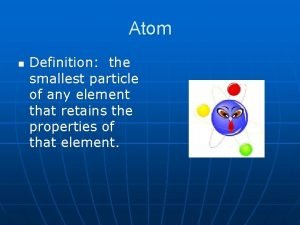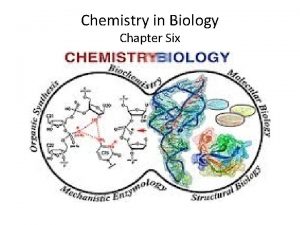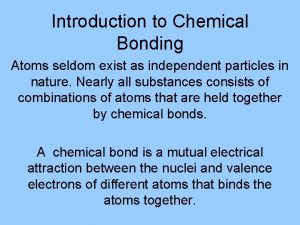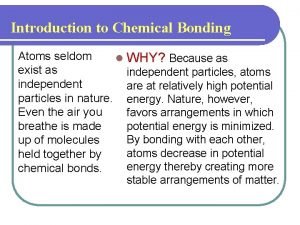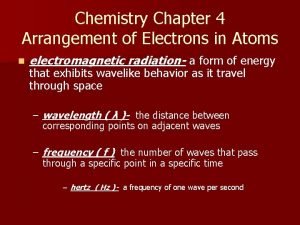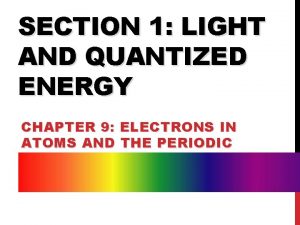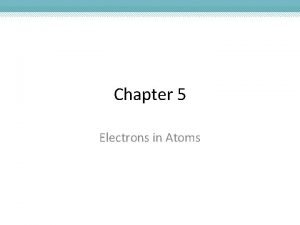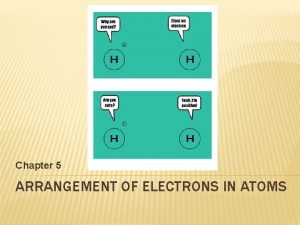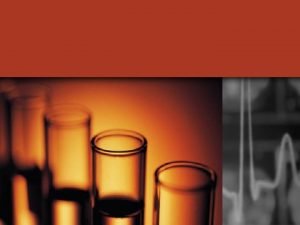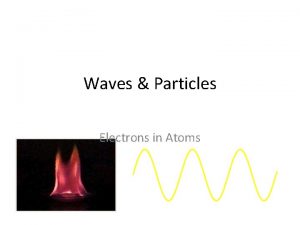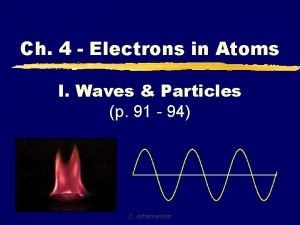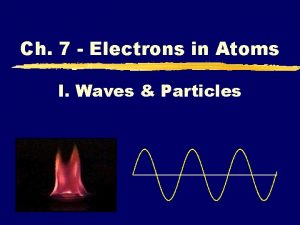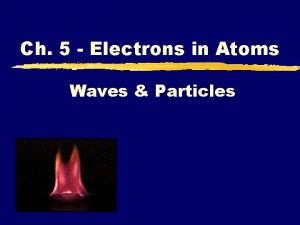Ch 4 Electrons in Atoms I Waves Particles













- Slides: 13

Ch. 4 - Electrons in Atoms I. Waves & Particles (p. 91 - 94)

A. Waves z. Wavelength ( ) - length of one complete wave z. Frequency (f) - # of waves that pass a point during a certain time period yhertz (Hz) = 1/s z. Amplitude (A) - distance from the origin to the trough or crest

A. Waves crest A greater amplitude origin (intensity) A trough greater frequency (color)

B. EM Spectrum H I G H E N E R G Y L O W E N E R G Y

B. EM Spectrum H I G H L O W E N E R G Y red R O Y G. orange green yellow B blue I indigo V violet E N E R G Y

B. EM Spectrum z. Frequency & wavelength are inversely proportional c = f c: speed of light (3. 00 108 m/s) : wavelength (m, nm, etc. ) f: frequency (Hz)

B. EM Spectrum z. EX: Find the frequency of a photon with a wavelength of 434 nm. GIVEN: WORK: f=c f=? = 434 nm = 4. 34 10 -7 m f = 3. 00 108 m/s -7 m 8 4. 34 10 c = 3. 00 10 m/s f = 6. 91 1014 Hz

C. Quantum Theory z. Planck (1900) y. Observed - emission of light from hot objects y. Concluded - energy is emitted in small, specific amounts (quanta) y. Quantum - minimum amount of energy change

C. Quantum Theory z. Planck (1900) vs. Classical Theory Quantum Theory

C. Quantum Theory z. Einstein (1905) y. Observed - photoelectric effect

C. Quantum Theory z. Einstein (1905) y. Concluded - light has properties of both waves and particles “wave-particle duality” y. Photon - particle of light that carries a quantum of energy

C. Quantum Theory z. The energy of a photon is proportional to its frequency. E = hf E: energy (J, joules) h: Planck’s constant (6. 6262 10 -34 J·s) f: frequency (Hz)

C. Quantum Theory z. EX: Find the energy of a red photon with a frequency of 4. 57 1014 Hz. GIVEN: WORK: E=? E = hf f = 4. 57 1014 Hz E = (6. 6262 10 -34 J·s) h = 6. 6262 10 -34 (4. 57 1014 J·s Hz) -19
 Atoms are small,hard particles
Atoms are small,hard particles How are the particles that make up atoms diagrammed
How are the particles that make up atoms diagrammed Atoms seldom exist as independent particles
Atoms seldom exist as independent particles Atoms seldom exist as independent particles
Atoms seldom exist as independent particles Atoms seldom exist as independent particles
Atoms seldom exist as independent particles Atoms seldom exist as independent particles
Atoms seldom exist as independent particles Regents periodic table
Regents periodic table Ccechs
Ccechs Chapter 4 arrangement of electrons in atoms
Chapter 4 arrangement of electrons in atoms Electrons in atoms section 1 light and quantized energy
Electrons in atoms section 1 light and quantized energy 7 ionic and metallic bonding practice problems
7 ionic and metallic bonding practice problems Electrons in atoms section 1 light and quantized energy
Electrons in atoms section 1 light and quantized energy Chapter 5 review arrangement of electrons in atoms
Chapter 5 review arrangement of electrons in atoms Atoms with 4 valence electrons
Atoms with 4 valence electrons
